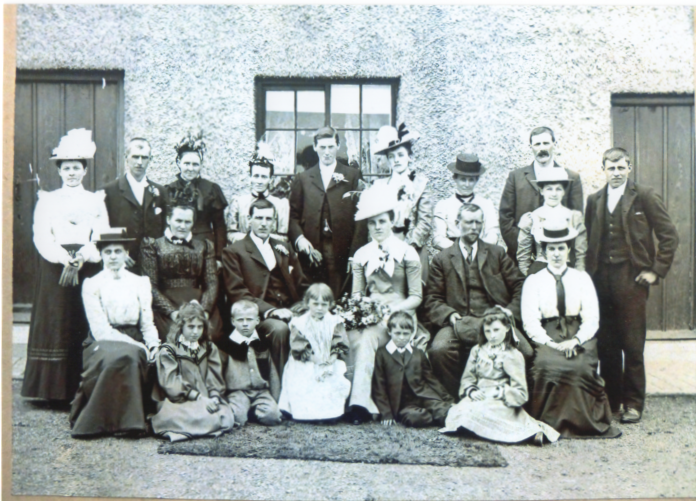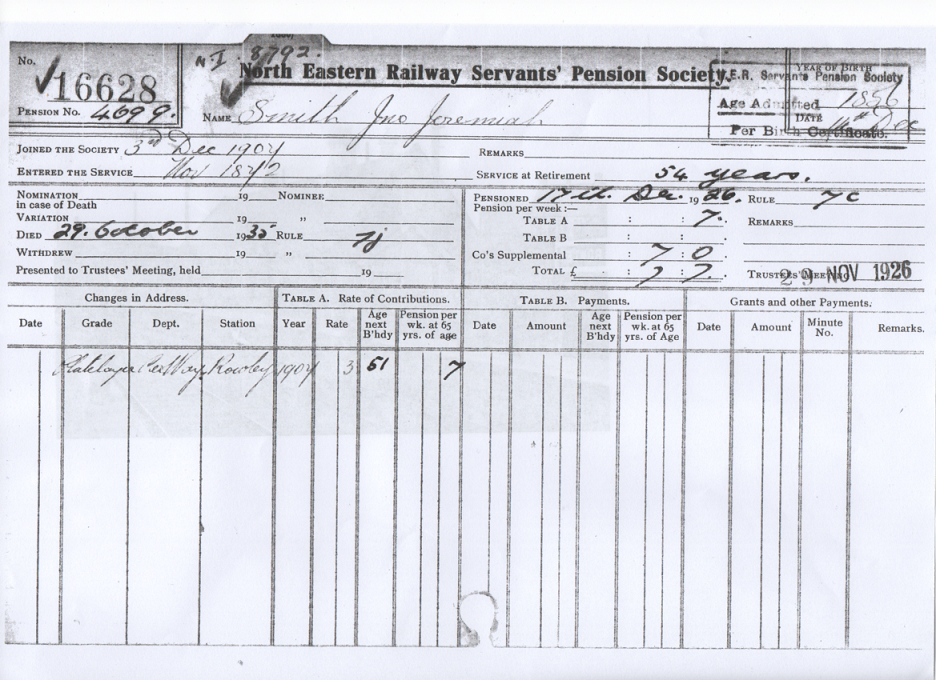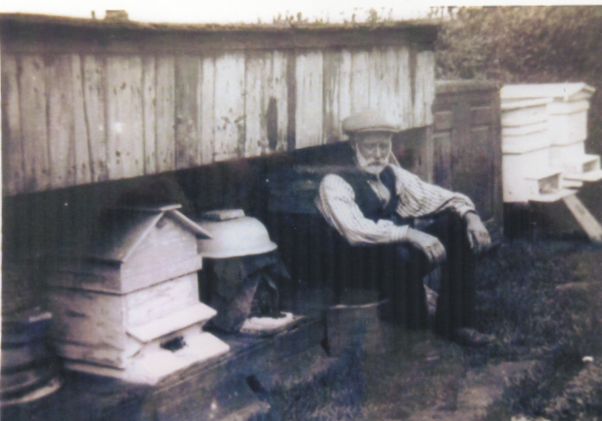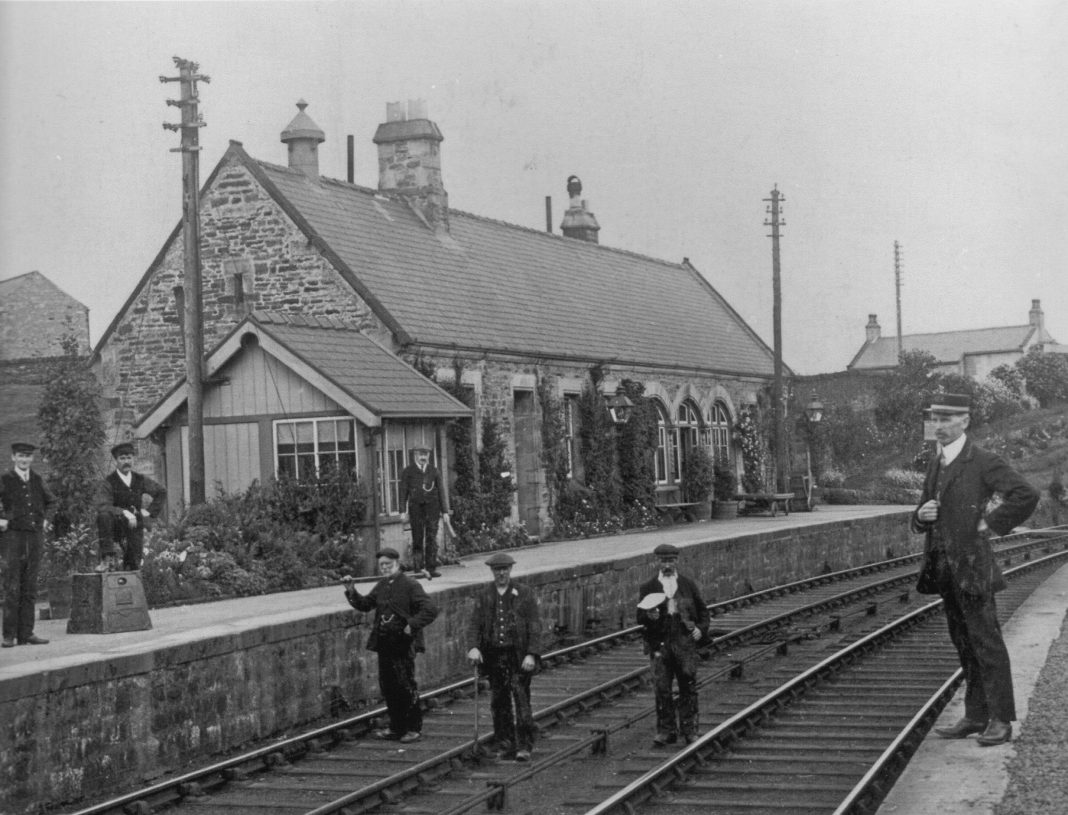Jeremiah was born on 14th December 1856 at Nurzen Field, a single dwelling house probably at Nursing Field Gill just south of Holmside between Burnhope & Edmondsley.
His mother Mary (Ann) Smith was 21years old & unmarried & no father was named on the birth certificate. Mary was Illiterate so was unable to sign the certificate. She named him Jeremiah after her brother.
In 1841 Nurzen Field was occupied by an agricultural labourer so it appears to have been a labourers dwelling. In 1851 Mary’s parents, John & Alice Smith, were living not far away at Burnhope Colliery & John was working as a labourer. It is possible that by 1856 Mary’s parents were living at Nurzen Field & that Mary was with them when Jeremiah was born.
We don’t know why Mary did not stay with her parents & bring up her son but by 1861 when he was 4years old Jeremiah was living with his grandparents & Aunt Alice in a cottage at Oliver Ford not far from Rowley & John was working as a woodman.
With a name like Mary Smith it has proven difficult to find information about her & if she had any continuing contact with her son.
By the age of 14 in 1871 Jeremiah was a charcoal maker at which he had probably been working for several years. (In the 1861 Census Henry Lidster only 11 years old, living at White Hall Cottage Healeyfield, was recorded as a lead mine labourer) Jeremiah’s grandfather was also recorded as a charcoal maker but at the age of 77 we can’t be sure he was still working, if not Jeremiah would have been the only regular wage earner.
The next ten years were to see enormous changes in Jeremiah’s life.
In November 1872 just before his 16th birthday he joined the North Eastern Railway as a platelayer giving him a job for life & a regular decent wage. The new station at Rowley, less than a mile from Oliver Ford, opened in 1873. He must have been one of the first members of staff to be based there.

At the time Thomas Lidster 55 a railway platelayer was living at White Hall Farm Cottage just west of Rowley & it’s possible that Jeremiah worked under him.
Throughout his teenage years Jeremiah’s grandparents were in their late 70s early 80s. We don’t know how well they managed, if they needed outside help or support from neighbours.
On 16th December 1876 Jeremiah now 20 married Martha Dixon Rutherford at Lanchester Register Office. Like his mother & grandfather before him he was illiterate & unable to sign the marriage certificate.
Martha was recorded as 18 years but she was only 16 being born in June 1860 at Warden near Hexham. She was the eldest of five siblings & their early lives were impoverished & traumatic. When she was 6years old her father died leaving his wife Jane with three small children & pregnant with a fourth. Three years later Jane remarried. How she coped in those intervening years we can only guess. Sadly only five months later Martha’s new stepfather died leaving Jane pregnant with her fifth child & we know by the 1871 Census Martha was in Hexham Poor Law Union Workhouse with her mother & three siblings. Jane had given birth to a son Samuel in June 1870 but he died in December before his first birthday. Infant mortality was quite high in many workhouses.
Hexham Workhouse had a school which the children would have attended. This gave them a better chance of getting a decent job & keeping them out of the workhouse in the future. There were usually several segregated categories of workhouse inmates & up to the age of seven children were generally with their mother but after that the children were resident in the school where they would learn the 3Rs – reading, writing & arithmetic plus the Christian religion. In addition an 1866 report on Hexham Workhouse records “the boys sometimes dig & plant the garden; the girls sew & knit & the elder assist in milking & churning for which two cows are kept.” Martha & her siblings were therefore literate & she & her sister Rachel were able to sign her wedding certificate.
From the workhouse Martha became a live-in farm worker which included field work possibly at Black Fine, Consett where she was living when she married.
Jeremiah & Martha started their married life at Oliver Ford with John & Alice now well into their 80s. Jeremiah was probably the only wage earner & Martha at sixteen was running a house of four. At this time the poor elderly unable to work had three choices – family support, parish relief or the workhouse.
Fifteen months later on 24th March 1878 at the age of 86 Alice died of senile decay & gangrene of the arm which she had suffered for twenty four days.
Martha was now pregnant & John, possibly failing in health, moved to be with his daughter Alice & her husband Joseph Ward, a miner, at Hamsterley Colliery where just six months after his wife he died of old age on 26th September 1878 aged 87.
In later years Jeremiah took his grandfather’s name and was known as John Jeremiah.
Twenty one days later on 17th October 1878 their first child George Herbert was born at Oliver Ford but soon after they moved to Fell Close a house at Healeyfield near the railway west of Rowley.
In February 1881 Martha was heavily pregnant with her second child. She had arranged that when the contractions started she would hang a cloth out of the window & the farmer’s wife down the hill would come & assist with the birth. On the 7th February, in his lunch break, Jeremiah went to check on his wife. He got a lift along on a train which dropped him off near the house. When he arrived he found Martha alone apart from her toddler son & a new born baby girl. The baby had come so quickly she didn’t have time to signal for help. Fortunately the birth went well & she managed to correctly cut the cord with a sharp knife.
In 1884 Richard Coulson was born & in 1892 William Ernest completed the family.
By the 1991 Census they were living in a house next to Rowley Station. After the 1872 Education Act there was now a school at Castleside which the children attended up to the age of twelve.
When the children were badly behaved Martha hit them with the clothes line probably not uncommon in those days.
By the 1901 Census Jeremiah, Martha, Lizzie & William were living at 4 Hownsgill Cottages built by the NER (before 1861) next to Hownsgill Viaduct(built 1858). The house had three rooms excluding scullery & bathroom. It’s doubtful whether they had a bathroom as they didn’t have running water. Water was obtained from a covered well down a zigzag path behind the cottages. This would mean they had dry toilets where they would put ash from the fire. It’s possible they didn’t have any other services to the cottages. They would burn combustible rubbish on the fire. Other rubbish seems to have been dumped down the hill behind the cottages where there was a large heap of ash, tins bottles etc. Any food waste would be given to their animals. Toilet waste would be collected to be spread on farm land & lighting would be provided by lamps & candles. There were allotments along the line for each of the cottages. Jeremiah kept bees which he could handle without any protection.

He also had a keen knowledge of the natural world around him. The women would often walk east along the line to shop at the large Co-op in Leadgate.
Jeremiah’s neighbours at Hownsgill in 1901 were:
1 Christopher Thomas 48 platelayer
2 Charles Hall 26? Checker in goods yard
3 Lambert Iley 46 platelayer
5 John Thompson 50 signalman
6 George Bowey 69 NER steam repairer depot?
When the children left school George worked in the Plate Mill at Consett Iron Company & Richard became a miner.
In 1893 Lizzie’s first job as a 12year old, with a friend, was to do the weekly wash for a local farmer’s wife using a poss tub & stick & mangle. They were each paid 6d. Later she became a postwoman & often walked many miles in all weathers delivering the post to local farms.
Martha & Lizzie also helped with the harvest bunching, binding & stooking the sheaves. To do this they took an armful of corn which they bound into a sheaf with a handful of corn twisted, wrapped & tied around. Corn stalks were longer in those days. They propped six or so sheaves up together to make the stooks to catch the wind & sun to dry out before being carted away to be stacked & later threshed.
As a teenager in the 1890’s Lizzie had a holiday with a friend on North Tyneside. One day her friend’s father was going up the coast on business & gave the girls a lift (by horse drawn vehicle) to spend the day at the beach. As they had no bathing costumes they went in the sea in their nighties.
William Smith became a live-in farm worker at East Butsfield Farm. By 1911 he was an agricultural contractor at one time carting ganister from Butsfield Quarry to Rowley Station from where it was taken by rail to CIC where it was used to line the furnaces. He served with the Northumberland (Hussars) Yeomanry Cavalry in WW1 during which he lost three horses & was wounded in the shoulder by a sniper. After the war he worked at Winlaton Mill Coke Ovens.
On 3rd December 1907 Jeremiah was enrolled in the NER Servants Pension Society contributing 3d a week.
(For many years governments had been struggling with ways to prevent people, particularly the elderly, from becoming destitute. In 1908 the State Old Age Pension was their solution)
In November 1907 Martha, at the age of only 47, had a stroke & died a month later on 17th December. This meant another move for Jeremiah to Consett Park Terrace to live with his daughter Lizzie & her husband William French.

William French had a good job as a blast furnace man becoming a blast furnace keeper by 1911. In his work gang he had a man who was “simple”. He would often ask the others to guess what was in his sandwiches & give an obvious clue e.g. “A hen laid it”. Today we recognise the wide range of people with special needs but can’t imagine a man with learning difficulties being employed as a blast furnace worker & yet that man found a place working alongside a gang involved in a dangerous & well paid job.
William had been able to buy a substantial stone built semi-detached house built in 1899 with 5 rooms plus a large scullery & bathroom. It had a very large garden which was put down to fruit & vegetables. Jeremiah had his bees & they kept hens & rabbits.
The hens were kept for their eggs & would only be eaten when they were past laying. Old hens would be killed by wringing their necks & were then “ploated” ( feathers plucked) preferably outdoors or in an outbuilding as the finer feathers would float all about the area. Soft feathers would be saved for feather pillows & mattresses. Boiled potato peelings or steeped stale bread would be mixed with meal to make “crowdie” for the hens.
The rabbits were kept for the pot being killed, skinned & prepared by Jeremiah or William. Lizzie would make a deep pie with a pastry top in the oven of the small iron range in the kitchen. The fire was rarely out & the heavy black kettle would stand on the hearth ready to boil for pots of tea.
Lizzie had her own transport, a pony & trap, which she loved. The pony was very lively. One day when visiting friends in the country as she was climbing into the trap ready to leave the husband was holding the pony’s head because it was restless & champing at the bit. He was concerned whether she would be safe but she said just to give him his head & off they went racing along the road at a spanking pace. As motorised vehicles increased on the roads horse drawn vehicles disappeared & she no longer had her own transport.
Lizzie helped neighbours giving birth & also with the laying out of the dead.
Lizzie & William had five children. On the 19th November 1928 Jeremiah’s granddaughter Annie died at the age of 20 with tuberculosis (galloping consumption) in a sanatorium at Bishop Auckland.

Jeremiah retired on 17th December 1926 at the age of 70 after 54 years with the NER at Rowley Station. His NER pension after 19 years of contributions was 7s 7d (38p) per week. He also had what his grandfather never had, a State Pension.
In retirement he liked to follow the Vale of Derwent Hunt on foot. Railway workers at rural stations were more like countrymen than industrial workers.

Jeremiah died on 29th October 1935 of a cerebral haemorrhage (bleed on the brain) & arterio sclerosis (hardening of the arteries). He kept most of his bees in the garden but at the time also had some hives on rough heathland near Todd Hills farm road not far from the house. On 29th two men walking past found him collapsed dead beside his bees. One of them went to the house & his son-in-law William & grandson Jack (John) carried him home on a nearby gate as an improvised stretcher. He was 79 years old.
His daughter Lizzie French administered his will in which he left £133 17s 2d.
(In year 2000 this was worth just over £19,000 ).





